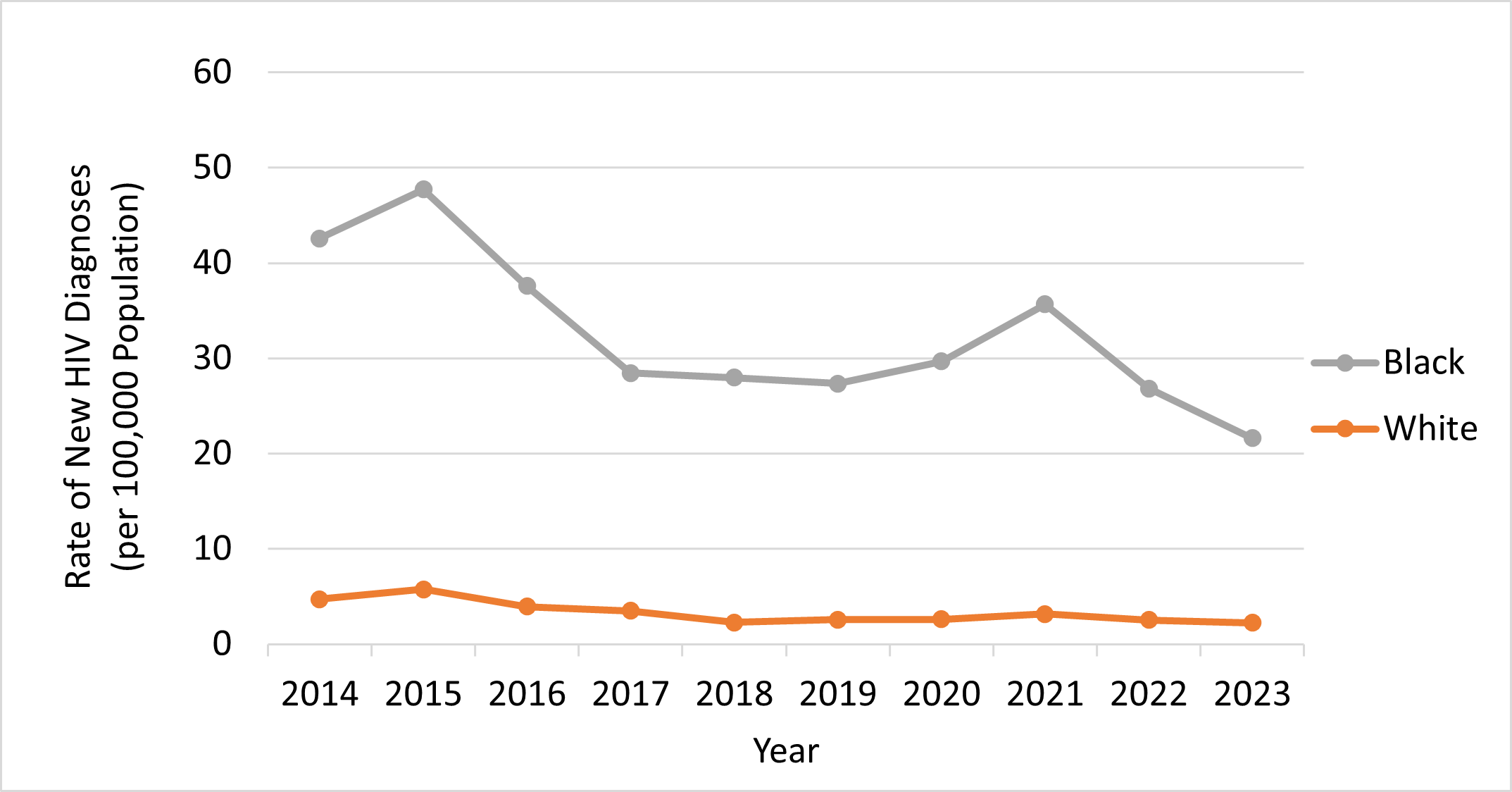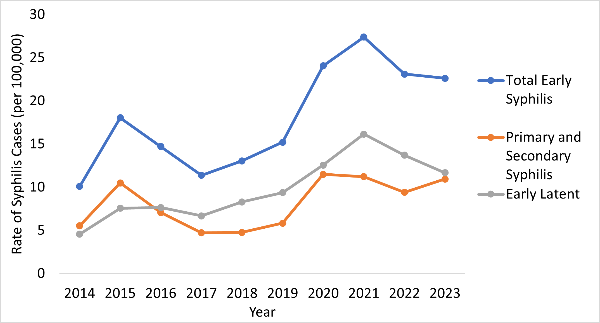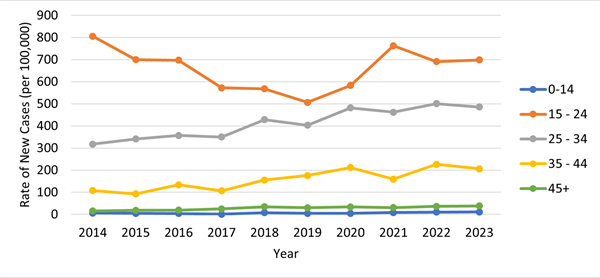Sexually Transmitted Infections

Overview of Sexually Transmitted Infections in Allegheny County, 2023
Sexually transmitted infections (STIs) remain a significant public health burden nationwide and in Allegheny County. In 2023, more than 2.4 million cases of chlamydia, gonorrhea and syphilis were reported in the U.S. 1 Between 2022 and 2023, gonorrhea has decreased by 7.2% while chlamydia has changed by less than 1% in the U.S. Primary and secondary syphilis has decreased 10.2% and early latent syphilis has decreased by 5.9%. However, cases of unknown duration or late syphilis has increased by 12.8%. Significant reductions in new cases are not only possible, but urgently needed to prevent the many negative long-term consequences associated with these infections.
This summary describes reported cases of four STIs (chlamydia, gonorrhea, syphilis and HIV/AIDS) in Allegheny County, focusing primarily on cases reported in 2023. The purpose of this summary is to inform healthcare providers, policymakers, residents and other community partners about the impact of STIs in the county. All reportable STIs have decreased between 2022 and 2023 (Table 1). In 2023, the rate of gonorrhea was higher in Allegheny County compared to Pennsylvania and the United States overall, while rates of early syphilis and HIV were lower (Table 2). Visit the ACHD HIV/STI Dashboard to learn more about rates of STIs and basic demographic information of those with various STIs.
Table 1. Overview of Reportable STDs in Allegheny County, 2022-2023
| Infection |
2022 |
2023 |
% Change |
| Chlamydia |
5,594 |
5,283 |
-6% |
| Gonorrhea |
2,532 |
2,455 |
-3% |
Early Syphilis*
|
285 |
279 |
-2% |
| HIV |
72 |
66 |
-8% |
*Early syphilis includes primary, secondary, and early latent syphilis cases
Table 2. Rates per 100,000 of Reportable STIs in Allegheny County, Pennsylvania, United States, 2023
| Infection Type |
Allegheny County |
Pennsylvania |
United States |
|
Chlamydia
|
431.3
|
421.2
|
492.2
|
|
Gonorrhea
|
200.4
|
144.7
|
179.5
|
|
Early Syphilis
|
22.8
|
19.4
|
31.8
|
|
HIV1
|
6.9
|
8.62
|
14.02
|
1HIV rates for individuals 15+ years in Allegheny County, and 13+ years in Pennsylvania and United States; 2Rates for PA and US are still preliminary for 2023 and may be adjusted.
HIV/AIDS
In 2023, there were 66 newly diagnosed cases of HIV reported in Allegheny County. These 66 cases represent an 8% decrease from the 72 newly diagnosed cases reported in 2022 (Figure 1). Most cases reported in 2023 were among males (80%) and individuals 15-34 years old (65%). Of the 66 cases, 19 cases (29%) were diagnosed with AIDS within 3 months of the initial HIV diagnosis, signifying late diagnosis of HIV. By comparison, 17% of newly diagnosed cases in 2022 were late diagnoses.
Figure 1. Newly diagnosed HIV cases in Allegheny County by sex at birth, 2014-2023

Black individuals made up 50% of new HIV diagnoses in 2023 and have made up the majority of new diagnoses in the last 10 years. However, the total number of diagnoses in both Black and white individuals has decreased since 2014. The rate of new HIV diagnoses per 100,000 population was almost 10 times higher in Black individuals compared with white individuals (Figure 2).
Figure 2. Rate of newly diagnosed HIV cases by race, Allegheny County, 2014-2023

Men who have sex with men (MSM) continued to account for a majority (56%) of newly diagnosed HIV cases, and heterosexual contact accounted for 14% of cases in 2023 (Figure 3). The risk factor was unknown for 21% of newly diagnosed cases.
Figure 3. Newly diagnosed cases of HIV in Allegheny County by risk factor, 2023

Syphilis
In 2023, there were 279 reported cases of early syphilis, including 25 cases of primary syphilis, 110 cases of secondary syphilis, and 144 cases of early latent syphilis. Total early cases of syphilis decreased from 2022 to 2023 by 2%. However, the rate of total early syphilis cases has more than doubled since 2014 (Figure 4).
Figure 4. Rate (per 100,000) of primary and secondary syphilis, early latent syphilis and total early syphilis cases reported in Allegheny County, 2014-2023
Of early syphilis cases, 85% were among males. The highest rates among males were among individuals 25-34 years old (Figure 5). The overall rate among males was 39.3 cases per 100,000 population, compared to 6.7 cases per 100,000 population among females.
Figure 5. Rate of early syphilis cases per 100,000 reported in Allegheny County by sex and age group, 2023

Black individuals represented 40% of early syphilis cases, which is down from 49% in 2022. While white individuals represented 43% of early syphilis cases, the rate of early syphilis per 100,000 population in Black individuals is 5.6 times that of white individuals.
Chlamydia
In 2022, there were 5,594 new cases of chlamydia reported in Allegheny County for a rate of 457.8 per 100,000 population, a 2% decrease from 2021. Chlamydia disproportionately affected Black persons with a rate more than 9 times that of white persons among cases with known race. Of all reported cases, 59% were among females, and among females, 84% were aged 15-29 years. Females 15-24 years had the highest rates of chlamydia, followed by males 20-24 years (Figure 5).
Figure 5. Rate of chlamydia infections per 100,000 reported in Allegheny County by sex and age group, 2022

Gonorrhea
In 2023, there were 5,283 new cases of chlamydia reported in Allegheny County. The rate of new chlamydia cases was 431 per 100,000 population, which is a 5% decrease from 2022. Despite this decrease chlamydia rates have remained relatively stable since 2014 (Figure 6). Chlamydia affected Black individuals at a rate 10 times that of white individuals (Figure 6).
Figure 6. Rate per 100,000 of chlamydia cases by race reported in Allegheny County, 2014-2023

Of all reported cases, 58% were among females. Females 15-24 years old had the highest rate of chlamydia, followed by males 15-24 years old (Figure 7).
Figure 7. Rate per 100,000 of chlamydia cases reported in Allegheny County by sex and age group, 2023

From 2014 to 2023, the rate of new chlamydia cases decreased by nearly 500 cases per 100,000 population among individuals 15-24 years old. In that same time period, there were slight increases among individuals 25-34 years old and 35-44 years old (Figure 8). The rate among males increased during this period (321 per 100,000 in 2014 to 364 per 100,000 in 2023), while there was a decrease in the rate of cases in females (596 per 100,000 in 2014 to 489 per 100,000 in 2023).
Figure 8. Rate of chlamydia cases per 100,000 reported in Allegheny County by age group, 2014-2023

Note: the age group 0-14 years has similarly small rates to the 45+ age group which is why it is difficult to see the overlapping lines.
Gonorrhea
There were 2,455 new cases of gonorrhea reported in Allegheny County in 2023. The rate of new cases of gonorrhea was 200 per 100,000 population, representing a 2% decrease from 2022 (Figure 9). Despite this small decrease from 2022 to 2023, rates of new gonorrhea cases have risen by 18% since 2014. Rates among Black individuals had a large decrease until 2019, when rates rebounded to those reported in 2014. In 2023, the rate of new gonorrhea cases for Black individuals was 11 times that of white individuals (Figure 9).
Figure 9. Rate of gonorrhea cases by race per 100,000 reported in Allegheny County, 2014-2023

More cases occurred among males (63%) than among females (37%). The highest rate of cases was among males was in individuals 25-34 years old, while the highest rate among females was in individuals 15-24 years old (Figure 10).
Figure 10. Rate of gonorrhea cases per 100,000 reported in Allegheny County by sex and age group, 2023

The increase in the overall rate of gonorrhea was driven by increases among males (167 per 100,000 in 2014 to 258 per 100,000 in 2023). There has been a small decrease in the female rate (172 per 100,000 in 2014 to 145 per 100,000 in 2023). The highest rate of gonorrhea cases was in individuals 15-24 years old (Figure 11). There was a decrease in reported cases for individuals 15-24 years old until 2019 when the rate started to rise again. Rates for both those 25-34 years old and 35-44 years old have increased by around 200 cases per 100,000 and 100 cases per 100,000 respectively, from 2014 to 2023.
Figure 11. Rate of gonorrhea cases per 100,000 reported in Allegheny County by age group, 2014-2023

Resources
Screening and Treatment
Prevention
- To reduce the risk of HIV and STI transmission use condoms. Free condoms are available through the ACHD Condom Distribution Program.
- Pre-Exposure Prophylaxis (PrEP) is a medication that is taken daily to lower chances of getting HIV. It is designed for individuals who are at high risk for getting HIV. Taking PrEP before you are exposed to HIV can reduce your risk of contracting the disease. Learn more about PrEP here: AIDS Free Pittsburgh PrEP Information.
- If you are an injection drug user, use sterile syringes and works. Learn more about accessing these materials: Prevention Point Pittsburgh Injection Supplies
Trends in HIV/STI Cases
AIDS Free Pittsburgh
AIDS Free Pittsburgh is a collaborative initiative comprised of government agencies, healthcare institutions, and community-based organizations that strive to support and improve the care of people living with HIV/AIDS, as well as communities most at-risk for HIV.
References
- Centers for Disease Control and Prevention. Sexually Transmitted Infections Surveillance 2023. Atlanta: US Department of Health and Human Services; 2024